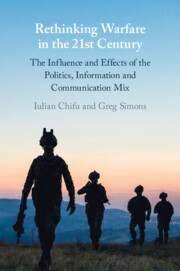 Rethinking Warfare in the 21st Century
Rethinking Warfare in the 21st Century Published online by Cambridge University Press: 29 June 2023
Culture and language are crucial elements of the information realm to interpret and represent contemporary armed conflict in the cognitive realm. They set the tone for how different audiences perceive mediated conflict events, which engineers observers’ opinions, perceptions and responses to the physical realm event. Language and culture have been instrumentalised by Western countries to facilitate conflict and warfare, creating unneccessary wars of choice through creating simple binary stories of ’Us’ versus the ’Other’ that attempt to convince the audience of the moral and ethical superiority of ’Us’ over the ’Other’. The result has been the Endless Wars and the rapidly expanding New Cold War.
To save this book to your Kindle, first ensure [email protected] is added to your Approved Personal Document E-mail List under your Personal Document Settings on the Manage Your Content and Devices page of your Amazon account. Then enter the ‘name’ part of your Kindle email address below. Find out more about saving to your Kindle.
Note you can select to save to either the @free.kindle.com or @kindle.com variations. ‘@free.kindle.com’ emails are free but can only be saved to your device when it is connected to wi-fi. ‘@kindle.com’ emails can be delivered even when you are not connected to wi-fi, but note that service fees apply.
Find out more about the Kindle Personal Document Service.
To save content items to your account, please confirm that you agree to abide by our usage policies. If this is the first time you use this feature, you will be asked to authorise Cambridge Core to connect with your account. Find out more about saving content to Dropbox.
To save content items to your account, please confirm that you agree to abide by our usage policies. If this is the first time you use this feature, you will be asked to authorise Cambridge Core to connect with your account. Find out more about saving content to Google Drive.